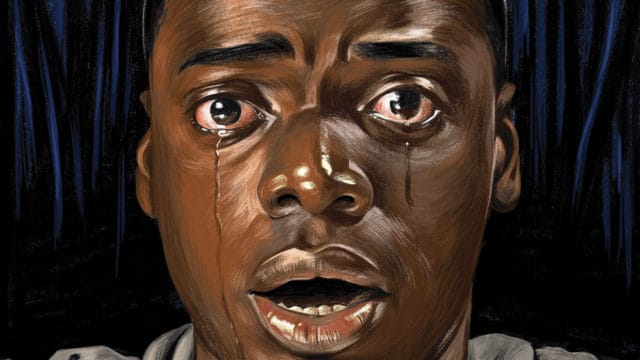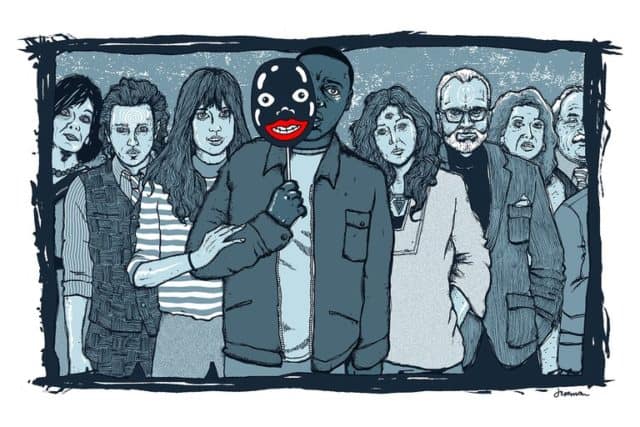
These are certainly strange times that we’re living in. Donald Trump is president of the United States (an event prophesied in The Simpsons eighteen years ago). Jumanji: Welcome to the Jungle, a latter day sequel that nobody thought would strike a chord with audiences, is the number one movie in the world right now. And, against all odds and reason, the Best Picture nominees with the clearest chance of winning the film industry’s top honor are horror movies.
Although in years past the smart money would be on historical biopics like The Darkest Hour or Phantom Thread, this is a new era for the Academy. They have a newer, younger, more colorful body of voters than at any other point of time in their history — and a mandate to honor films that better reflect not just what great works are being produced, but which ones strike a chord with the movie-going public — and that changes everything.

This is why Mad Max: Fury Road was a Best Picture nominee a few years back. This is why Moonlight beat La La Land despite what everybody thought going into the night. This is why Logan is a Screenplay nominee and why Get Out and The Shape of Water are the likeliest films to win Best Picture this year. The nature of the game has changed, and all the old rules have been thrown out.
This year’s Best Picture contest has felt like a two-film race since the start of awards season at the tail end of last year. They both have astonishingly positive reviews. They are popular among the general movie-going public (a feature that far too people give the proper time of day in these competitions). They have been cleaning up awards left and right. They appeal to the youthful voting bloc that has been driving the Academy’s decisions for the last couple of years now.

One is the product of a brand-new face behind the camera. Jordan Peele’s directorial debut is a genuine tour de force in a genre far too often relegated to disposable schlock to binge watch in October. It is a powerful statement about the state of race relations in 21st century America, told by the kind of filmmaker that never seems to get a fair shake in Hollywood.
The other is an exquisitely rendered vision by an industry mainstay (whether the studios that run it like him or not). Guillermo del Toro is an old hat at raising pulp stories above their generic origins and presenting a one-of-a-kind spectacle that you simply can’t find anywhere else. But despite his singular genius behind the camera, he has had to fight Hollywood every step of the way: at once seemingly exiled from major studio work after the disastrous reception of the producer-botched Mimic, and certainly never getting his fair share of industry praise for the work he has produced over his tenure.

Had you asked me a month ago which of these films was likely to walk away with the award, I would have said Get Out. It is a spectacular film with even more stellar reviews than that descriptor might suggest. It’s from a man who has turned out to be an unprecedented talent, released at a time when the film’s message was most resonant. It was undoubtedly the year’s most profitable film — making back more than twenty-five times what it cost to get into theaters — and has remained a relevant and powerful contender despite its initial release early in the year.
However, the way that things stand now, The Shape of Water has overtaken it as the film to beat in 2018. Despite a strong initial showing for Get Out in the awards circuit, it has failed to capture the various awards it has been nominated for. Meanwhile, The Shape of Water has garnered remarkable momentum by cleaning up many of the industry’s major awards, from many of the industry’s major guilds and branches. Coupled with the Academy preference to award overdue filmmakers (and, by proxy, their entire body of unrecognized work) rather than unknown quantities in youthful newcomers, it definitely has the edge over Get Out.

Maybe I’m wrong, though. The Academy has gotten significantly younger in a few short years, after all. Maybe they are more eager to award fresh talent when it presents itself. Or maybe they’ll both lose out to one of the more traditional films that they’re competing with. After all, two “genre” films stand a very good chance of splitting the vote and keeping whatever large bloc of academy voters from uniting under a single film: enough so, perhaps, to give one of the other seven film’s an edge in beating it out. We’ll just have to wait and see when the award is handed out next month.
 Follow Us
Follow Us





